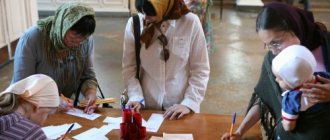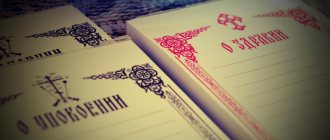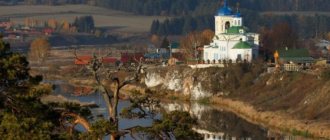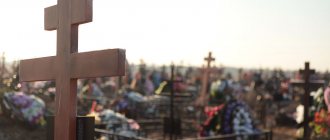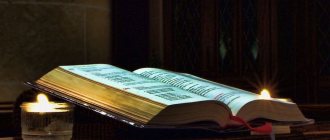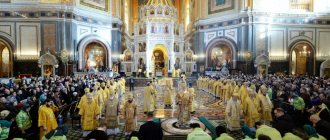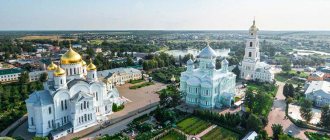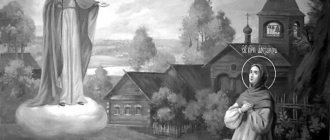List of monasteries with this service
Submitting a note for eternal funeral commemoration is not possible in all monasteries. In most cases, this chant is available in large cities. The sacrament is offered to parishioners in churches that are undergoing reconstruction. Construction work requires a lot of funds; priests encourage material donations. At the end of construction, the acceptance of notes stops.
In some large monasteries, the list for eternal Orthodox commemoration is constantly updated. You can find out information about this sacrament in a candle shop. In most cases, the donation amount is 11,000 rubles. In some churches the price is 2–3 thousand rubles.
A list of monasteries with eternal remembrance has not been compiled. You can find out information in this area for free from parishioners or priests.
Need expert advice?
Get expert advice online. Ask your question right now!
Ask a free question View all questions
Reception of notes for the implementation of regular chants is carried out in the Kazan Cathedral in St. Petersburg. Here prayers are read for people who still lived in pre-revolutionary times. The ancient tradition is observed after many years.
Eternal sacred remembrance is available to parishioners of the Holy Vedensky Monastery, which has a long history. The church accepts registrations for funeral rituals. The donation amount is symbolic and amounts to 3 thousand rubles. You can transfer funds to a bank card. If a person is unable to come in person, the archimandrite can be contacted by telephone or email.
You can submit a note to the monastery for the daily sacrament online through the special Treba platform. The resource allows you to conduct eternal Orthodox commemorations in the Holy Churches, which were destroyed in Melenki 80 years ago. Priests gather to conduct services in temporary premises. Liturgies, memorial services and prayer services are held on the territory. The icon of the faithful Prince Peter and Fevronia of Murom is considered a special shrine. Some of the relics of the saints have also been preserved.
Monetary donations helped in the construction work of the dilapidated monastery. Recovery began in mid-summer 2015. At the moment, the laying of the 3rd tier of walls has been completed. The formation of a covering in the form of a tent is approaching.
Story
According to folk legend, this place was under the power of evil spirits and was called “Khutyn”, that is, a bad place. Here the monk Varlaam (in the world Alexa Mikhalevich) retired to prayer. One day Prince Yaroslav came to him. Saint Varlaam, blessing him, said, “Be healthy, prince, and with your noble son.” This greeting amazed the prince, who did not yet know about the birth of the baby (this was in 1190). Having cut down the cell and having won victory over evil spirits, he erected first a wooden and then a stone temple in the name of the Transfiguration of the Lord (Church of the Savior in Khutyn). The church was consecrated on August 6, 1192 by Archbishop Gregory. The temple has not survived. In 1515, the Transfiguration Cathedral was built. The most famous building of the monastery is the Church of Gregory of Armenia.
In 1471, John Vasilyevich the Third came to the Khutyn Monastery to venerate the holy relics, and, according to legend, he began to ask the abbot why the crayfish were not opened so that everyone could venerate the holy relics. When, at his command, they began to dig up the grave of the Monk Varlaam, a pillar of fire burst out of the ground, scorching the wall and the southern door of the iconostasis. The Grand Duke ran out of the church in horror, striking the ground with his staff, and fire came out of the ground not only in the church, but also in the monastery. Throwing away his staff, the Grand Duke left the monastery in great fear. This staff and the scorched altar door were kept in the monastery sacristy.
In 1553-1557, the abbot of the monastery was a major hagiographer and the most prominent singer of the Novgorod school of the 16th century, Markell Bezborody.
In 1611, the monastery became the residence of the command of the Swedes who attacked Veliky Novgorod.
Since the mid-18th century, the abbots of the Khutyn Monastery were vicars of the Novgorod diocese, who bore the title of Kexholm and Ladoga (1759-1763), Starorussky (1787-1892), Kirillovsky (1892-1907), Tikhvinsky (1907-1921).
The ashes of the great Russian poet Gabriel Romanovich Derzhavin and his wife Daria Alekseevna are buried in the Spaso-Preobrazhensky Cathedral of the Khutyn Monastery. Derzhavin died in 1816 in his house on the Zvanka estate. The coffin with the body of the deceased on a barge along the Volkhov went to its final resting place. Archbishop Anthony (Znamensky), Bishop of Starorussky Sylvester (Tsvetkov) and Bishop of Kirillov Arseny (Ivashchenko) were also buried in the monastery cathedral.
The monastery was closed in 1925, but until 1932 services were still held in the monastery cathedral. The title of Archbishop of Khutyn was held by Alexy (Simansky); in the cathedral in 1930-1932, the future Archimandrite Pavel (Gruzdev) sang and read in the choir.
During the Great Patriotic War, the monastery was destroyed and remained in ruins for more than 40 years. Derzhavin’s grave was also damaged. In 1959, the remains of the poet and his wife were reburied in Novgorod Detinets. In 1993, in connection with the 250th anniversary of the poet, his remains were returned to the monastery.
What will such a commemoration give to the deceased?
The unchangeable truth of Orthodoxy remains the assertion that a person’s eternal life does not end after death. Flesh decomposes over time, the immortal substance continues to live in the afterlife. Believers are convinced that after death there is bliss for the righteous and torment for sinners. You can change your fate while on earth through repentance, prayers and good deeds.
The main meaning of funeral services is to pray for the deceased, so that the Creator will forgive the sins of the deceased. Eternal sacred remembrance in monasteries gives strength to save lost souls.
The church has special days when the dead are remembered. Prayers open the way for the dead from the gates of heaven to earth to their relatives. The main moment of the eternal sacrament is the Divine Liturgy. In the proskomedia, a small part of the prosphora is dropped into the bowl after the communion ceremony. The human soul undergoes purification and is imbued with the energy of grace.
By giving alms, the deceased receive the favor of the Almighty. The spirit, which is located in the place of torment, atones for its sins.
Eternal Orthodox commemoration in monasteries has sacred meaning for living people. Having performed a good deed, a person automatically adheres to the commandment of love for others. Almsgiving is an effective tool for obtaining forgiveness for sins committed.
The question of eternal remembrance
Church services in churches and monasteries of Orthodox Jerusalem
Our prayer request to God must be supported by a willingness on our part to bring something as a gift. This has been known since the earliest biblical times. This is the spiritual meaning of sacrifices and various types of donations. Therefore, already in the ancient Church people made monetary contributions. Holy John Chrysostom explained to those who in his time did not understand the meaning of fees: “Don’t be embarrassed - heavenly blessings are not sold for money, they are not bought with money, but by the free decision of the one giving the money, through philanthropy and alms. If these goods were bought with silver, then the woman who put in two mites would not receive much. But since it was not silver, but a good intention that had power, she, showing all her readiness, received everything. So, we should not say that the Kingdom of Heaven is bought with money - not with money, but with a free decision that manifests itself through money. However, you say, do you need money? It's not money that's needed, but a solution. Having it, you can buy heaven for two mites, but without it, even for a thousand talents you cannot buy what you can buy for two mites.”
The donations that believers make have two sides. One is spiritual and moral, and the other is life-practical.
The Lord says about the spiritual side: Sell your possessions and give alms. Prepare for yourselves a sheath that does not wear out, an unfailing treasure in heaven, where no thief approaches and no moth destroys, for where your treasure is, there will your heart be also (Luke 12:33-34). And St. The Apostle Paul writes: You sent me to Thessalonica once or twice for my needs. I say this not because I am looking for giving; but I seek fruit that will increase for your benefit (Phil. 4:16-17)
Custom mass
For the person commemorated at the Liturgy, a particle is taken out of the prosphora and immersed in the chalice with the Holy Mysteries (Body and Blood of the Lord Jesus Christ). Thus, the soul of the person for whom this cleansing sacrifice is offered on the Throne receives grace and sanctification. Eternal remembrance at mass will be performed at every Liturgy for as long as the monastery exists.
Eternal memory...
Commemoration of a person during the time this temple stands. When the Bolsheviks destroyed ancient monasteries and churches, they found memorial lists from pre-Mongol times. That is, the person in this temple was commemorated every day for many centuries.
When a destroyed temple is restored, then, if possible, eternal remembrance is sought, and remembrance begins again. I remember my service as a reader at the Kazan Cathedral in St. Petersburg. My obedience was precisely to read the eternal memorial, which, fortunately, was printed before the revolution in a typographical way. When the temple began to operate again, this memorial (it was produced in a small edition) was taken, photocopied, bound and commemorated daily. Among many names (and there the name, patronymic, and surname of the person commemorated were written out in calligraphy), there were the names of Father John of Kronstadt, Blessed Xenia, and many prominent Russian figures of cult, art, and aristocracy. Eternal remembrance is usually made for a significant donation to the temple or is performed as a result of a person’s special merits to this temple (monastery). The names of the clergy who worked here are automatically included in the eternal remembrance of the temple.
Separately, we note: at all church services we pray only for baptized Orthodox Christians. We do not commemorate those excommunicated from the Church, heretics, schismatics, the unbaptized, and suicides in church. We pray for such people only at home. In some cases, church authorities or a priest make a special decision.
Special request
A special petition is intense prayers for a person during the Divine Liturgy; they are pronounced aloud by the priest before the Throne of God. Usually such commemoration is ordered for the sick, traveling, and the deceased.
About commemoration The Church makes the main prayer for the health of the living and the repose of deceased Orthodox Christians at the Divine Liturgy, offering a bloodless sacrifice to God for them. To do this, before the start of the liturgy (or the night before), you should submit notes to the church with their names (only baptized, Orthodox Christians can be entered). At the proskomedia, particles will be taken out of the prosphoras for their health or for their repose, and at the end of the liturgy they will be lowered into the holy chalice and washed with the Blood of the Son of God as a sign of Christ’s washing away human sins. Let us remember that commemoration at the Divine Liturgy is the greatest benefit for those who are dear to us
Sorokoust
Sorokoust is a daily prayer remembrance for forty days. The number forty is a significant number, often found in the Holy Scriptures. The Jewish people wandered in the desert for forty years, the prophet Moses fasted for forty days, the Savior after His Baptism spent forty days in the desert, and after His Resurrection, for forty days he taught the Apostles the secrets of the Kingdom of God.
The first Apostles legitimized in the Church of Christ the Old Testament custom of mourning the dead for forty days. On the basis of this, the Holy Church, from ancient times, established the rule of commemorating the dead for forty days (Sorokoust) and especially on the fortieth day. Just as Christ defeated the temptations of the devil, spending forty days in fasting and prayer, so the Holy Church, offering prayers, alms and bloodless sacrifices for the deceased for forty days, helps the deceased by the power of God to defeat the airy prince of darkness and receive the Kingdom of Heaven. According to tradition, for 40 days the Church prays not only for the dead, but also for the living. Sorokousts “for health” are ordered to perform forty days of church prayer for the living at the Liturgy, at prayer services and while reading the psalter. Elder Schema-Archimandrite Zosima noted that the entire history of mankind is measured in “weeks and forties.” “For forty days Christ appeared to his disciples, remaining on earth until the Feast of the Ascension of the Lord. The holy holiday is the fortieth day of the Ascension of the Lord. We celebrate Easter on the eve and will celebrate the great annual holiday on the fortieth day after Easter - the Ascension of the Lord. Sorokoust - forty days of fasting, forty days of Easter, everything comes in forties, weeks and forties. And the history of mankind also goes on in weeks and forties.”
An ancient custom among Orthodox Christians is the so-called magpie - reading the Psalter 40 times for the soul of the deceased. (Not to be confused with the other Sorokoust - daily commemoration during the Liturgy for 40 days.) They usually try to perform the Sorokoust in the near future after his death, i.e. in the first 40 days. The very purpose for which magpies are ordered is, without a doubt, good. But they can be beneficial only when they are performed without selfish intentions, when prayer is a feat and not a providence. Therefore, it is advisable that the magpie be trusted to be read either by someone close to the deceased who is passionately concerned about his salvation, or by someone humble and non-covetous. A person who is obviously selfish should not be entrusted with this. Sorokoust is read for the repose of the soul of only one person and in no case for several. When in the old days in monasteries the funeral psalter was read for many, such reading was constant, “incessant,” and sometimes continued for decades.
Eternal simple remembrance
Such commemoration is performed by the sisters at Divine services for the entire time that the monastery exists. In the event of the death of the person being commemorated, his neighbors must inform the monastery about this so that the name can be copied into the memorial “about repose” (you need to indicate the date of ordering the commemoration in order to find the name in the memorial). You can order such a commemoration for the deceased, his name will be written down immediately in the memorial “for repose”.
The everlasting psalter
In many places there is a custom of asking monasteries to read the Psalter for the departed and for health, which is combined with giving alms. At the monastery, the sisters constantly read the Psalter (the indefatigable psalter) with the remembrance of names (about health and repose). Great is the power of this unceasing prayer.
Reading the Psalter drives away demons from a person and attracts God's grace. The Indestructible Psalter is a special kind of prayer. The never-ending psalter is so called because its reading takes place around the clock, without interruption. This kind of prayer is prayed only in monasteries. You can give for both the living and the deceased. Prayer for the living and the dead while reading the indefatigable Psalter has unprecedented power, which crushes demons, softens hearts, and appeases the Lord so that he raises sinners from hell
The Indestructible Psalter... Why is this so important? For many reasons
1. Monks have the special grace to beg the laity. The monks live by prayer; they have taken on the image of an angel. And real monks have the prayer of earthly angels. But if the monks are weaker, the prayer still has great power and the prayer gets through. 2. The Psalter is a prayer of the strongest power. Venerable Ambrose of Optina: “You will see through experience how great the power of God-inspired psalm words is, which scorch and drive away mental enemies like flame. And prayer is always stronger with psalm words than with our own.” Elder Jerome of Sanaksar said that where the Inexhaustible Psalter is read, it is like a pillar of fire reaching to the sky. 3. The peculiarity of the Psalter prayer is that when one prays for a person during this prayer, it greatly protects him from evil demons and helps in the fight against passions. As St. says Parthenius of Kiev, The Psalter tames passions. 4. Also, the most important feature of the rite of the Indestructible Psalter is that you will be commemorated every day and usually several times a day. Those. some monasteries commemorate not only once a day, but at every kathisma (The Psalter has 20 kathismas, 20 parts). 5. The indefatigable Psalter is read not only during the day, but also at night. That is why this rank is called indestructible, because does not stop day or night. The monks replace each other after a certain amount of time. 6. The indefatigable Psalter is read not only about health, but also about peace. Since ancient times, ordering commemoration on the Everlasting Psalter has been considered a great alms for a departed soul.
7. As St. Augustine said, the love of psalmody gave birth to monasteries. It is highly desirable for a monastery to have this rank. This is a stronghold of monasteries. When you order this rank, you support this monastery. This is a very generous alms. After all, the benefit is not only to the person for whom the order was made, but: 1) to you, since this is a matter of mercy; 2) to the monastery, since this is support for the monastery as a whole; 3) to the monks, because they participate in this ceremony; they feel that they are benefiting from this and feel that their prayer is reaching 4) with your example you can also inspire someone nearby, if they suddenly find themselves or in a spiritual conversation with someone (without revealing your alms and its size) 5) when you see the result (and it will definitely happen), you will be strengthened in your faith. It is also good to order the Indestructible Psalter for yourself, you will clearly feel the support. And one more important point, but far from the least important, there is eternal remembrance on the Undying Psalter. It seems expensive, but the result is more than millions of times more than the money spent. If this is still not possible, then you can order for a shorter period. It's also good to read for yourself.
Prayer services
A prayer service is a special divine service in which they ask the Lord, the Mother of God, and the saints to send mercy or thank God for receiving benefits. In church, prayer services are usually held after the liturgy. Public prayer services are performed on temple holidays, on New Year's, before the start of the youth's teaching, during natural disasters, during invasions of foreigners, during epidemics, during rainlessness, etc. Other prayer services belong to private worship and are performed at the requests and needs of individual believers. Often during these prayers there is a small blessing of water. The note for the prayer service begins with an indication of which saint the prayer service is offered to. Then the names of those for whom the prayer song will be offered are listed.
Sometimes a person ordering a prayer service does not wait for it to be completed and leaves the temple, leaving only a note. The Lord accepts every sacrifice, but it is much more effective to pray with a priest than to leave him to beg God for us. Sometimes akathists and canons are added to prayer services. Often, priests, completing the service, anoint those praying with blessed oil and sprinkle with holy water. According to our faith, the Lord gives His help very soon after the prayer service. Therefore, there is no need to abuse this sacred rite by ordering a prayer service several times for one reason (with the exception of prayer for the sick and serving votive prayer services).
Memorial service
According to the teachings of the Holy Orthodox Church, all believers in the Lord Jesus Christ do not die, but live forever. “Whoever lives and believes in Me will never die” (John 11:26). Therefore, dying Orthodox Christians do not cease to be members of the Holy Church, maintaining prayerful communication with all its other children. “Anyone who wants to show their love for the dead and give them real help can best do this by praying for them. A funeral service for the dead, at which the departed are prayerfully remembered and, trusting in God’s mercy, they ask for forgiveness of sins and blessed eternal life. Requiem services are held both before the burial of the deceased and after - on the 3rd, 9th, 40th day after death, on his birthday, namesake, and on the anniversary of death. In addition to memorial services for individual deceased, the Church also performs the so-called. ecumenical or parental funeral services. They are served on special days called parental Saturdays.
In the Orthodox Church there are special liturgical services for praying for the departed - requiem mass and lithium. The memorial service is somewhat similar in its procedure to the funeral service (without reading the Apostle and the Gospel, prayer of permission, etc.). Usually a memorial service is performed in churches on days of general remembrance of the dead or at the special request of believers.
Commemoration for Lent
During Lent, a special commemoration is held in the monastery. Names (of health and repose) are remembered by the sisters at Divine services every day throughout Lent.
In which churches and monasteries can you order church services?
Jerusalem Orthodox Church (Jerusalem Patriarchate)
1. Monastery of St. Theodosius the Coenobiarch Holy Monastery of the Hegumen Theodosius the Coenobiarch. Hegumen: Archimandrite Ierotheos. Tel. +972-2-2761223 and +972-505-282447 (mob). Greek Orthodox Convent, PO Box 183, Bethlehem.
2. Monastery of St. Gerasimos of Jordan Holy Monastery of the Hegumen Gerasimos of Jordan. Hegumen: Archimandrite Chryssostomos, 3 monks, 4 novices. Tel. +972-505-348892 (mob). Greek Orthodox Convent, PO Box 35, Jericho. Tel. +972-2-9943038
3. Monastery of Saint Sava Holy Lavra of our Holy and Godbearing Father Savva the Blessed Abbot: His Beatitude the Patriarch of Jerusalem Theophilos Confessor: Archimandrite Evdokimos Stewart: Monk Ioannikios, Monks 16 Postal Address: Holy Laura of St. Savvas, POBox 19824, Jerusalem Tel: +972-2-2762915
4. Monastery of St. George Hozevite (St. George) Holy Monastery of Saint George the Hozevite Caretaker: Archimandrite Chrysostom Tel: +972-29943038 and +972-505-348892 Monks and novices: 4 Postal Address: Greek Orthodox Convent, PO Box 35, Jericho Israel.
5. Monastery of Temptation (Carantal) Holy Monastery of Mount Sarantario (of Temptation) Abbot : Archimandrite Gerasimos Tel: +972-2-2322827 Postal Address: Greek Orthodox Convent, POBox 21, Jericho
6.Orthodox monastery on Mount Tabor Holy Monastery of Mount Tabor. Hegumen: Archimandrite Ilarion, +972-522-413348, 6 monks. Greek Orthodox Convent, PO Box 184, Nazareth. Tel. +972-4-6620262 and fax: +972-4-6732297.
7. Monastery of Saint John the Forerunner Holy Monastery of Saint John the Forerunner in Jordan. Caretaker: Archimandrite Chryssostomos. Greek Orthodox Convent, PO Box 35, Jericho. Tel. +972-2-9943038, +972-505-348892
8. Monastery of Prophet Elijah (Deir-Mar-Ilyas) Holy Monastery of Prophet Elijah. Hegumen: Archimandrite Andreas. Tel. +972-2-6760966, +972-522-379419, +972-544-629066 Greek Orthodox Convent, PO Box 312, Jerusalem 91002.
9. Church of St. Saint George Church in Lydda. Hegumen: Archimandrite Sophronios. Tel. and fax: +972-8-9222023, mob. +972-547-519812. Greek Orthodox Convent, PO Box 230, Lod.
10.Church of the Cathedral of the Twelve Apostles (Capernaum) Holy Monastery of the Saint Apostles in Capernaum Abbot: Archimandrite Irinarchos. Tel. +972-528-858421 (mob.) Greek Orthodox Convent, PO Box 385, Tiberias. Tel. +972-4-6722282 and fax: +972-4-6791535
11. Temple of St. Photinia of the Samaritan Woman. Jacob's Well, Nablus Holy Monastery of Jakob's Well in Samaria. Hegumen: Archimandrite Justin. Tel. +972-9-2313123, +972-599-658385 Greek Orthodox Convent, Nablus.
· Russian Orthodox Church Outside of Russia ROCOR MP
1. Olive Spaso-Voznesensky Convent Abbess Moses Mount of Olives Convent PO Box 19229 Jerusalem 91191, Israel Tel: 972-2 / 628-4373 Tel: 972-2 / 628-0111 Fax: 972-2 / 628-2367
2 Russian Orthodox Gethsemane Convent and Church of St. Mary Magdalene Equal to the Apostles Abbess Elizaveta Gethsemane Convent PO Box 19239 Jerusalem 91191, Israel Tel: 972-2 / 628-4371 Fax: 972-2 / 628-6381
3. Monastery of Chariton the Confessor in the Judean Desert Skete of Saint Chariton PO Box 20164 Jerusalem 91200, Israel 4. Sunday School in Bethany Contact Information: Bethany School PO Box 20607 Jerusalem 91205, Israel Tel: 972-2 / 279-0316 community Tel: 972 -2/279-9797 school
5. Alexander Nevsky Metochion in Jerusalem Chairman of the Palestinian Orthodox Society (IPOS Jerusalem): Vorontsov Nikolay Alexandrovich Orthodox Palestinian Society 25 Dabbagha Street POBox 991 91009 Jerusalem
web order form
· Commemoration at the Divine Liturgy · Blessing of the Water · Prayer for health · Prayer for repose · Prayer for health · Indestructible psalter · Candle for repose · Candle for health · Sorokoust for repose · Sorokoust for health · Requiem service
Current state of the monastery
The Transfiguration Cathedral remains the custodian of the relics of St. Varlaam, over which a silver shrine was erected. Under the wise leadership of the abbess of the monastery, Abbess Alexia (Simdyankina), more than a hundred nuns live.
The spiritual mentoring of the convent is carried out by Abbot Macarius (Shamsutdinov), who has a truly spiritual gift of love for people and enormous patience. After communicating with the priest, many parishioners left, illuminated by the light of his smile, taking with them the anointing and advice.
You can confess and get advice from Father Macarius before the Liturgy. Parishioners and pilgrims can pray in the Khutyn chapel, located on a hill, according to legend, made by the Monk Varlaam himself with the help of a skufia, and drink water from a well dug by the saint himself.
Donation
Recommended donation for 1 name:
- Prayer service, memorial service, proskomedia (1 day) - 5 rubles
- Proskomedia, Sorokoust (40 days) - 300 rubles
- Proskomedia (1 year) - 1000 rubles
- Indestructible Psalter (1 year) - 1000 rubles.
For the existence of the monastery and its inhabitants, material resources are necessary. Therefore, we ask you for a voluntary donation for the needs of the monastery. The form automatically calculates the recommended donation. You can change its size at your discretion.
If you are in a difficult financial situation that does not allow you to donate to the monastery, write us a letter to
and explain the situation. The decision will be made individually.
The main shrine of the monastery is the relics of St. Varlaam
Spaso-Preobrazhensky Varlaamo-Khutyn Convent Official website
The relics of St. Varlaam of Khutyn are still the main shrine of the monastery and are kept under wraps, that is, they are not open for worship.
Above them there is a silver shrine with the image of the monk, as reported by the official website of the monastery.
Cancer with the image of a saint.
Divine services in the monastery church are held daily: on weekdays at 7:30 and 18:00, and on weekends at 9:00 and 18:00. You can order requirements in the monastery shop.
Current state
Since April 20, 1994, it has been an active convent. Abbess: Abbess Alexia (Simdyankina). About 100 sisters live in the monastery, and there is a courtyard in the village of Bykovo, Valdai region.
The confessor of the monastery is Abbot Macarius (Shamsutdinov). According to one of the pilgrims: “The most indelible impression on me was made by Father Abbot Macarius. In the busy world in which we live, I am amazed every time I meet such amazing people. I would compare Father Macarius’s attitude towards other people with the kindness and love of Christ. Next to such a person, you begin to feel light within yourself. As a child, you learn to love people in a new way, and for that I am grateful. I will carry the image of his glowing smile with me throughout my life.” In the words of another pilgrim: “He has from the Lord the gift of love and consolation. No matter how many pilgrims come, he has a smile and a kind word for everyone, he anoints everyone with oil on the hill after the prayer service, everyone is prepared with a bucket of water from the well, regardless of the weather and time of year. Pilgrims jokingly call Fr. Macarius as a hydromonk." K o. People from many cities in Russia come to Macarius for spiritual advice and help; he receives confession before the start of the Liturgy.
Venerable Varlaam Khutynsky and his monastery
Today is the day of remembrance of St. Varlaam
The veneration of the saints and the people’s love for them cannot be destroyed by persecution, destruction, or fear - this is evidenced by the history of the monastery of St. Varlaam of Khutyn, Novgorod miracle worker. For almost a millennium, pilgrims have been drawn to this quiet, picturesque place ten kilometers away from the city on the banks of the Volkhov. And, as during the life of St. Varlaam, and many centuries after his death, receive consolation, healing, and joy.
The Monk Varlaam was born in Novgorod the Great at the beginning of the 12th century. Tradition has even preserved evidence of the place of residence of the ascetic in the ancient city - grateful admirers erected a chapel at this place - on the Sofia side, at the Nerevsky end near the earthen rampart. It is known that Rev. Varlaam was the son of a wealthy Novgorod citizen Mikhail and his wife Anna. After the death of his parents, Alexei Mikhailovich distributed all his property to the poor and took monastic vows in one of the Novgorod monasteries. However, his soul longed for complete solitude, and he began to look for a place where he could hide from the bustle of the city.
Like many Christian ascetics, St. Varlaam chose exactly the place that was notorious among the people. Monasticism is the essence of spiritual warfare, which is why many of our saints began their feat by settling in those places that have long been the abode of evil power. Novgorodians also knew about such a place with a bad reputation, and it was not for nothing that they nicknamed it “Khutyn”, a bad place. From the life of the saint we know that he received a sign from God to settle in Khutyn. When he walked along the bank of the Volkhov, he saw a ray of light coming from the thicket of the forest. In that place he cut down his cell, and then “in memory of the heavenly light that overshadowed him here,” he built a temple in honor of the Transfiguration of the Lord. The temple was consecrated in 1192, St. On this day, Varlaam was elevated to the rank of abbot, since good brethren had already gathered around him. This event is mentioned in the Novgorod Chronicle.
History of the foundation of the Novgorod shrine
Varlaamo-Khutyn Monastery is a Christian shrine, founded at the beginning of the 12th century, now a monastery for women. Previously, there was a monastery here, where the miraculous relics of St. Barlaam of Khutyn are kept.
The Monk Varlaam is one of the revered saints of the Russian north. He was born into a wealthy Mikhalevich family and was baptized with the name Alexy. From an early age, the boy showed curiosity in learning the Word of God, absorbing its revelations.
Alexy's parents left this world early, leaving a large inheritance, which as a young man was distributed to the poor, and he himself took monastic vows with the name Varlaam.
One day, while praying, the monk saw a bright light from a deep forest, which the locals considered unclean. At the place indicated from Heaven, in the depths of an impenetrable thicket, the saint spent all his time in prayer. In memory of the divine appearance, the first temple of the future Khutyn monastery was consecrated as the Holy Transfiguration.
The consecration of the church took place on August 19, 1192, and on the same day Archbishop Gregory Varlaam was ordained hegumen, however, due to health reasons, he was the mentor of the monastery for only 2 months, and handed over his beloved brainchild to the leadership of Father Anthony. On November 19 of the same year, the Monk Varlaam rested peacefully.
Interesting! The anointing sown by the saint at the monastery bore fruit; after prayer at the saint’s grave, miracles of healing began, people kept coming and coming to the resting place of the Monk Varlaam.
History preserves several legends both during the life ministries and after the death of the miracle worker.
St. Varlaam predicted snow in Novgorod during Peter's Fast, after which, according to the monk, summer would instantly come, bringing a rich harvest. And so it happened. This miracle was marked by a solemn service and a solemn procession around the monastery walls.
In the 15th century, the Grand Duke of Moscow Ivan III wanted to open the grave to ensure the incorruption of the relics, but was stopped by a sudden flame emanating from the coffin. Tongues of fire accompanied the king during his flight from the shrine. The scorched royal staff was kept for a long time in the Transfiguration Church.
In the 16th century, the Varlaam Monastery was the center of both church and political life.
In 1611, the Swedes, who took Veliky Novgorod under siege, established their residence in the monastery.
Vicars of Kexholm and Ladoga, Starorussky and Kirillovsky, Tikhvinsky, each at one time was the abbot of the Khutyn monastery.
By the end of the 19th century, famous people of Russia were buried here:
- the great Russian poet Gavrila Derzhavin and his wife Daria;
- Archbishop Anthony;
- Bishop Sylvester (Tsvetkov);
- Archimandrite Arseny (Ivashchenko) and others.
Time of closure and destruction
The monastery retained this status until the October Revolution of 1917. Despite the official closure, in 1925, services were conducted in the monastery churches by Archbishop Alexy (Simansky), and until 1932, divine services were performed in the choir by the future Archimandrite Pavel (Guzeev).
Before the war, within the monastery walls there was a military school, and later, as a desecration of a shrine, a hospital for mentally ill people.
The Great Patriotic War destroyed the Varlaam shrine, leaving it in ruins for forty years, and Derzhavin’s tombstone was also damaged, whose remains were later reburied, then in 1993 returned to the monastery.
Return of the shrine
At the end of the 20th century, the restoration of the Novgorod shrine began, and a convent was already operating here.
In 1998, renovation work was completed in both areas:
- southern - Intercession of the Virgin Mary;
- northern, consecrated in the same year in honor of John the Theologian.
In 2003, the Varlaam Church and the refectory bell tower, in which the Church of the New Martyrs and Confessors of Russia was consecrated, were finally restored.

